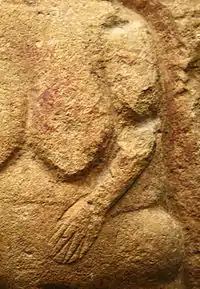Venus of Laussel
The Venus of Laussel is an 18.11-inch-high (46.0-centimetre) limestone bas-relief of a nude woman. It is painted with red ochre and was carved into the limestone of a rock shelter (Abri de Laussel) in the commune of Marquay, in the Dordogne department of south-western France. The carving is associated with the Gravettian Upper Paleolithic culture (approximately 25,000 years old). It is currently displayed in the Musée d'Aquitaine in Bordeaux, France.




Description
The figure holds a bison horn, or possibly a cornucopia, in one hand, which has thirteen notches. She has large breasts, a great stomach, and wide hips. There is a "Y" on her thigh and her faceless head is turned toward the horn. The lower relief was covered in red ochre.[1]
Discovery and display
The relief was discovered in 1911 by Jean-Gaston Lalanne, a physician. It was carved into large block of limestone in a rock shelter (abri de Laussel) at the commune of Marquay in the Dordogne department of south-western France. The limestone block fell off the wall of the shelter. It was brought to the Musée d'Aquitaine in Bordeaux, France.
Meaning
The figure and the horn are considered significant in figurative studies of Paleolithic art. There are 144 similarly formed "goddess figures" said to be used for the worship of a Great Goddess discovered across present day Europe, such as Venus of Willendorf.[2][3][4] The color and the number of notches on the horn may symbolize the number of moons or the number of menstrual cycles in one year, or the number of days from menstruation to ovulation.[1]
References
- Thompson, William Irwin. (1981). The time falling bodies take to light : mythology, sexuality, and the origins of culture. New York: St. Martin's Press. p. 105. ISBN 0-312-80510-1. OCLC 6890108.
- Eisler, Riane Tennenhaus (1987). The chalice and the blade : our history, our future (1st ed.). Cambridge [Mass.]: Harper & Row. p. 5. ISBN 0-06-250287-5. OCLC 15222627.
- Neumann, Erich (4 May 2015). The Great Mother : an analysis of the archetype. Manheim, Ralph, 1907-1992 (First Princeton classics ed.). Princeton, New Jersey. ISBN 978-1-4008-6610-6. OCLC 908042725.
- "Venus of Willendorf: How This 30,000-Year-Old Figurine Continues to Captivate Today". My Modern Met. 2019-10-06. Retrieved 2020-10-15.
Further reading
- Eisler, Riane (1995), Sacred Pleasure: Sex, Myth, and the Politics of the Body, HarperCollins Publishers Inc., NY.
- Marshack, Alexander (1971). The Roots of Civilization, Moyer Bell Ltd, Mount Kisco, NY.
External links
| Wikimedia Commons has media related to Venus of Laussel. |